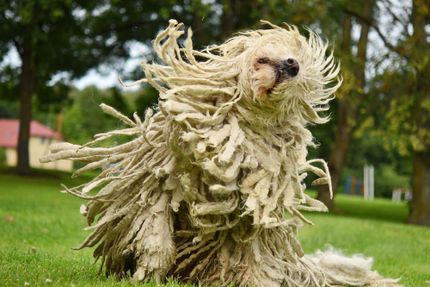Saint Pyrenees:Saint Bernard and Pyrenean Mountain Dog Mix
Facts & Origin
St. Bernard and Pyrenean Mountain Dog Mix - a hybrid breed.
This mixed breed is the best of both worlds. The St. Bernard is known for its gentle and loyal character, while the Pyrenean Mountain Dog is an excellent protector. Together, they make the perfect family pet.
The Saint Bernard Pyrenean Mountain Dog, also known as the Saint Bernard Pyrenees Mountain Dog, is a breed of large, strong and long-lived dogs that originated in the Pyrenees Mountains of Europe. They are often used as rescue dogs, avalanche dogs, and companion dogs, and are known for their intelligence, loyalty, and gentle nature. Their size and coat also make them well suited to cold climates. They are an extremely loving and patient with children and other animals, but require regular exercise and mental stimulation to stay happy and healthy.
| Alternate Name | - |
| Origin | Switzerland - France |
| Life expectancy | 8 - 12 years |
| Care requirements | high-maintenance |
| Activity level | average |
| FCI group | not recognised |
| AKC group | not recognised |
| KC group | not recognised |
More Saint Bernard mixes
More Pyrenean Mountain Dog mixes
Attitude, character and temperament of the breed
Possible character traits of Saint Bernard and Pyrenean Mountain Dog Mix - Such is probably his nature.
A Saint Bernard Pyrenean Mountain Dog mix, also known as a Saint Pyrenees, is a fun-loving and sociable dog that makes a great companion. They are loyal and protective of their family and make great watchdogs. They are friendly to everyone they meet and love to play. This mix is not for everyone as they need a lot of exercise and have a lot of room to run. They are also very strong and can be difficult to handle if not trained properly. But if you are looking for a large, friendly, lovable dog, the Saint Pyrenees is the perfect choice!
Character
Usage


Health and breeding information
What diseases can occur in St. Bernard and Pyrenean Mountain Dog Mix.
The Saint Bernard Pyrenean Mountain Dog mix is a unique and interesting breed. As with any mixed breed, there is no guarantee that your dog will be free of genetic disorders. However, the St. Bernard Pyrenean Mountain Dog mix is known to be particularly prone to certain diseases.
One of the most common health problems in the St. Bernard Pyrenean Mountain Dog mix is joint problems. This is because both the St. Bernard and the Pyrenean Mountain Dog are prone to hip and elbow dysplasia. Hip dysplasia is a condition in which the hip joints do not fit together properly. This can lead to pain and lameness. Elbow dysplasia is similar but affects the elbow joint. Both conditions can be painful and lead to arthritis.
Another health problem in the St. Bernard Pyrenean Mountain Dog mix is bloat. Bloat is a condition where the stomach twists, causing gas and fluid to build up. This can be very painful and fatal if not treated immediately. The best way to prevent bloat is to feed your dog small meals throughout the day rather than one large meal.
The St. Bernard-Pyrenees Mountain Dog mix is also prone to heart problems. Both the St. Bernard and the Pyrenean Mountain Dog are prone to a condition called dilated cardiomyopathy, a disorder of the heart muscle. This can cause the heart to enlarge and eventually fail.
Finally, the St. Bernard-Pyrenean Mountain Dog mix is also prone to cancer. Both the St. Bernard and the Pyrenean Mountain Dog are susceptible to several types of cancer, including lymphoma, bone cancer, and breast cancer.
Although the St. Bernard Pyrenean Mountain Dog mix is prone to some health problems, it is still a wonderful breed. With proper care and regular veterinary checkups, your St. Bernard Pyrenean Mountain Dog mix can live a long and healthy life.
What does this mixed breed look like?
The coat of a St. Bernard Pyrenean Mountain Dog mix is long, thick and silky. The coat is typically light to dark brown, with a black mask and black markings on the feet and legs.
What are breed characteristics of this mix dog?
The St. Bernard Pyrenean Mountain Dog mix has a dense, long coat that is usually white with brown or black patches. They have a large, muscular body and can weigh up to 90 kg. The shoulder height can be up to 80 cm.
| Fur length | medium |
| Fur | flat coated - |
| Ear shape | Triangle |
| Tail | fanned out |
| Anatomy | strong, rugged, massive |
| Size ♀ | 65 - 80 cm |
| Weight ♀ | 36 - 120 kg |
| Size ♂ | 70 - 90 cm |
| Weight ♂ | 50 - 120 kg |
| Suitable For | - |
Known Diseases
Epilepsy
Definition: Dog has epilepsy if, for example, at least two epileptic seizures occur more than 24 hours apart.
Cancer
May be common in older dogs.
Skeletal disorders
IPA, FPC and OCD occur in dogs at four to five months of age during the most severe growth spurt.
FAQ
-
A St. Bernard-Pyrenean Mountain Dog mix is a cross between two of the most popular large dog breeds. The St. Bernard is known for its rescue work and the Pyrenean Mountain Dog for its strength and size.
-
Saint Bernard and Pyrenean Mountain Dog mixes can weigh between 80 and 90kg and can grow up to 80cm tall. Some are known to grow even larger.
-
The average life expectancy of a St. Bernard-Pyrenees Mountain Dog mix is 10 to 12 years.
-
Saint Bernard and Pyrenean Mountain Dog mixes need a lot of exercise. They are very active dogs and need plenty of room to run and play. A daily walk or run is a must for these dogs.
-
Saint Bernard and Pyrenean Mountain Dog mixes have moderate grooming needs. They need brushing a few times a week and their claws should be trimmed regularly.
Useful Articles
You can find articles that might interest you in the dogbible blog to match your favorite breed.
Visit our magazineto stay up to date on dog trends.
To find out more, view our Privacy Policy
Find here the breed that suits you and find out what character traits it has. Here you can also learn more about the origin, size and weight of your favorite breeds.
Matching your favorite breed, you'll find articles that might interest you on the dogbible dog blog.
BH exam for the dog - procedure, costs, tips
Dry dog food vs. wet food - which makes more sense? Which is healthier?
How do you get the dog used to wearing a mask because of Corona?

















